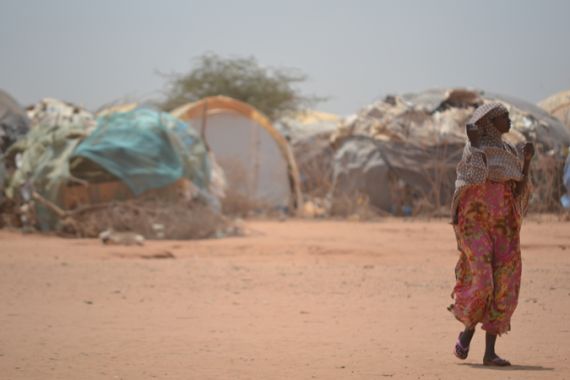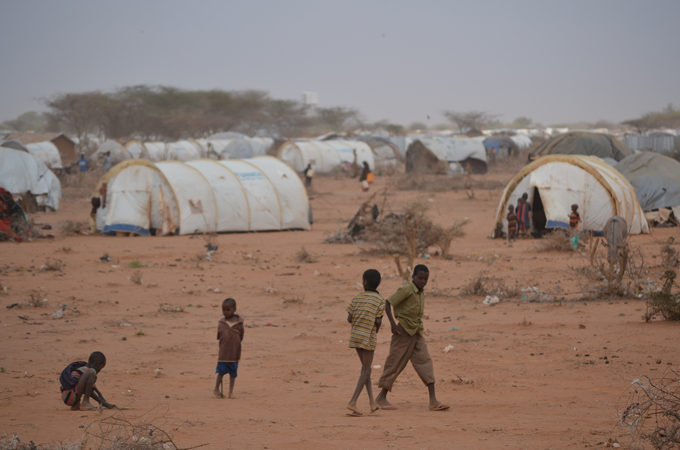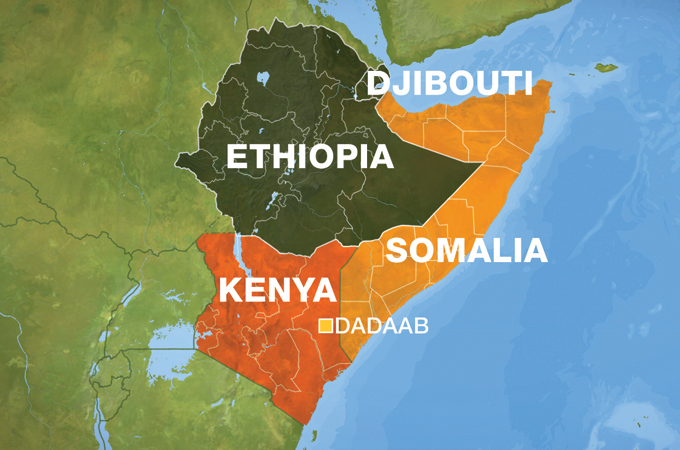Dadaab, the world’s biggest refugee camp
Desperation reigns amid the 380,000 refugees in Dadaab, a sprawling “tent city” in northeastern Kenya.

 |
|
A humanitarian disaster is imminent as conditions worsen in the world’s biggest refugee camp. [Azad Essa/Al Jazeera] |
Dadaab, Kenya — I am tying my shoelaces when the early morning call to prayer begins to sound over the scratchy loudspeakers at the neighbourhood mosque.
It’s an early start from Garissa; we need to get to Dadaab and get cracking with our coverage.
And so, just as light begins to streak through the night sky, I gingerly slide myself into the rented Land Cruiser. I am asked if my room was fitted with a mosquito net to prevent contracting malaria from the blood sucker buzzing about.
“No … and I was eaten alive last night … so wait, does that now mean I have malaria?” my voice begins to crackle in mild trepidation.
“Nah – you are on the medication, so you should be fine … or … well, you will know either way in two weeks,” is the collective reply.
Two weeks to malaria, then.
I look out the window and watch the sun rise slowly over the prairie.
The road from Garissa to Dadaab resembles a wide, dry river bed. The road has been so beat up, it feels as though you’re driving in a shallow bowl flanked by river banks and layered in different textures of sand – from the rock-hard to the soft desert grains – giving the easily distracted more than one reason to drift.
This is not a safari
Outside my window, two tall giraffes strike up dust as they glide with elegant nonchalance through the rough, drought-resistant vegetation beside us. Moments later, we slow down and allow a herd of camels ambling through the sandy motorway to pass, but as we motor our way further across the bumpy road, a tiny deer hops across the road, forcing our Toyota to grind to a momentary halt. I remind myself that we are not in a game park and this is not a safari. Thousands of people have trekked across the wild for days hiding from militia and police by day and hyenas by night, to escape the insecurity of violence and famine in nearby Somalia.
 |
Some three hours later – after suffering repeated whiplash every time our excitable driver plunged carelessly into a dip at full throttle – we reach the UNHCR headquarters in Dadaab.
According to the UN’s security system, the entire North East province of Kenya is classified a security level four – indicating a level of substantial threat. Trips to the various camps that make up the Dadaab complex need to be taken under a security escort to mitigate the risks, some of which include raids by bandits and attacks by forces loyal to al-Shabab.
In reality, the thousands of refugees undertaking the grueling journey from Somalia are at far greater risk of encountering bandits or stealth attacks from al-Shabab. The dramatically heightened security measures seem to be a purposeful attempt to set a security standard; “just in case”.
The world’s biggest refugee camp
Throughout the journey, I had wondered what a refugee complex widely billed as the largest in the world would look like. The widely distributed aerial photographs from the UN from back in the early nineties show the staggering scope of the settlements. They are enough to give one the shivers.
In an area spanning 50km, just two hours away from the Kenyan-Somali border, three camps – Dagahaley, Ifo and Hagadera – were originally set up to host a total of 90,000 people.
Twenty years later, with more than 380,000 people registered as refugees at the Dadaab complex, I was curious as to how the camp had changed.
And if the camps were indeed overflowing with people as we’d been told over and over again, where are the new arrivals living?
We are quickly ushered around the UNHCR reception centre in Dagahaley. We are greeted by the sight of a few hundred people standing behind barbed-wire fences waiting to be registered as refugees by both the Kenyan authorities and the UN, so they might be given a ration of food, a mat, a pot and a white plastic sheet to cover the hut they are to build out of branches, twigs and sticks.
Each camp sees hundreds of new arrivals each day. The registration process is arduous, and some only complete their registration days after their arrival – sometimes, even a week – this, after walking for anything between five and 20 days to get here in the first place.
Slow burn pain
Inside the Médecins Sans Frontières/Doctors without Borders (MSF) hospital in Dagahaley, a collection of makeshift structures made of wood and steel, hundreds of children were being treated for severe malnutrition. On each bed in the paediatric ward an anxious parent, usually a mother, sits, resting tentatively with their infant.
The sight invoked memories of images of those Somali and Ethiopian children with deep-set eyes and sunken cheekbones splashed liberally across television news bulletins all those years ago – in the eighties and nineties – with disturbing regularity.
The doctors and nurses here say that the first few days after arrival are most crucial for these children’s survival. Far too many are in a critical condition. Over the past two months, the number of babies needing immediate care has doubled, precariously stretching the capacity of available medical infrastructure. One nurse tells me that it is simply not possible to keep up with the demand and they are forced to focus on primary health care. Many parents and children are traumatised after making such a long, difficult journey.
In the outskirts of the Dagahaley camp where we go following the trip to the hospital, we find seventy-odd unmarked graves, jutting out of the earth in a plot of land between the tents and huts. These are the graves of infants and young children who had died shortly after arriving; their graves conspicuous by their tiny lengths and by the freshness of the dug-up soil.
Some of these graves are merely a few days old.
Here, the community congregates around our team as we try to arrange an interview with a mother whose child is one of the deceased.
She appears to laugh when asked about her child.
Of course, she isn’t really a grieving mother – or maybe she was? We cannot tell.
Besides, we are crouching beside unmarked graves in a refugee camp within an institutionalised refugee complex that has become too full to allow new refugees to set up a home.
Yes, read that again.
There we were, trying to converse with a woman who had walked more than 100km to save her family from starvation only to see her child buried in an unmarked grave in a camp abandoned by the world.
The entire situation defied conventional wisdom. Why then did we expect her to offer us a normal picture of grief?
Tent city
But this was where the new arrivals had set up.
Thousands and thousands of tents and wooden huts, held together by branches, stems, and topped by a plastic sheet distributed as part of the UNHCR rations, dotted the plateau.
These people had yellow tags on their wrists, indicating that they had been registered, but they were in the middle of nowhere with little food, no sanitation, very little livestock (though donkeys perused the drought-resistant weeds with some fervour and dropped faeces around the camp with equal venom), waiting for something to happen.
And they just keep on coming. Hundreds, perhaps thousands, continue to brave the desert, feeding roots of trees to their children, begging for water and hiding from bandits as they look for a place to just live.
This, then, was the humanitarian crisis on our hands.
We call it a day.